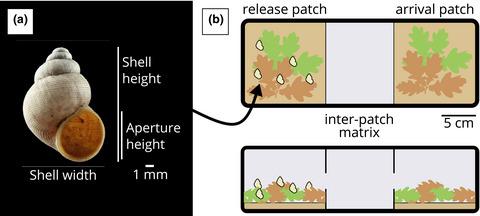Our official English website, www.x-mol.net, welcomes your feedback! (Note: you will need to create a separate account there.)
Increased population density depresses activity but does not influence emigration in the snail Pomatias elegans
Journal of Zoology ( IF 2 ) Pub Date : 2020-11-07 , DOI: 10.1111/jzo.12846 M. Dahirel 1, 2 , L. Menut 1 , A. Ansart 1
Journal of Zoology ( IF 2 ) Pub Date : 2020-11-07 , DOI: 10.1111/jzo.12846 M. Dahirel 1, 2 , L. Menut 1 , A. Ansart 1
Affiliation

|
Dispersal is a key trait linking ecological and evolutionary dynamics, allowing organisms to optimize fitness expectations in spatially and temporally heterogeneous environments. Some organisms can either actively disperse or reduce activity in response to challenging conditions, and both responses may be under a trade‐off. To understand how such organisms respond to changes in environmental conditions, we studied emigration (the first step of dispersal) and activity behaviour in the gonochoric land snail Pomatias elegans, a litter decomposer that can reach very high local densities, over most of the range of ecologically relevant densities. We found that crowding had no detectable effect on emigration tendency in this species, contrary to previous results in many hermaphroditic snails. Pomatias elegans is nonetheless able to detect population density; we show they reduce activity rather than increase dispersal in response to crowding. We propose that limiting activity may be more advantageous than moving away in species with especially poor movement abilities, even by land mollusc standards, such as P. elegans. Interestingly, emigration and activity were positively correlated independently of density; this dispersal syndrome may reflect an underlying pace‐of‐life syndrome and is compatible with a dispersal‐dormancy trade‐off, which would require further investigation. Additionally, we found snails with heavier shells relative to their size tended to be less mobile, which may reflect physical and metabolic constraints on movement and/or survival during inactivity. We finally discuss how the absence of density‐dependent dispersal may explain why P. elegans is often found at very high local densities, and the possible consequences of this behaviour for ecosystem functioning and litter decomposition.
中文翻译:

人口密度的增加抑制了蜗牛的活动,但不影响蜗牛的迁徙。
分散是将生态和进化动力学联系起来的关键特征,使生物能够在空间和时间异质环境中优化适应性期望。某些生物可以在挑战性条件下主动分散或降低活性,这两种响应都可能处于折衷状态。为了了解此类生物如何响应环境条件的变化,我们研究了淋病蜗牛蜗牛的分解过程中的迁移(扩散的第一步)和活动行为,该分解物可以在很高的范围内达到很高的局部密度。与生态相关的密度。我们发现拥挤对该物种的迁徙趋势没有可检测到的影响,这与许多雌雄同体蜗牛先前的结果相反。秀丽线虫仍然能够检测种群密度。我们显示出他们减少活动而不是增加对人群拥挤的反应。我们建议限制活动可能比移走行动能力特别差的物种更为有利,即使是通过陆地软体动物标准(例如秀丽隐杆线虫)。有趣的是,移民和活动与密度呈正相关。这种弥散综合症可能反映了潜在的生活节奏综合症,并且与弥散性休眠折衷方案兼容,这需要进一步研究。此外,我们发现壳相对于其大小较重的蜗牛往往活动性较差,这可能反映了在不活动期间运动和/或生存的物理和代谢限制。我们最后讨论不存在依赖于密度的散布的现象如何解释为什么秀丽隐杆线虫通常在很高的局部密度下发现,以及这种行为对生态系统功能和凋落物分解的可能后果。
更新日期:2020-11-07
中文翻译:

人口密度的增加抑制了蜗牛的活动,但不影响蜗牛的迁徙。
分散是将生态和进化动力学联系起来的关键特征,使生物能够在空间和时间异质环境中优化适应性期望。某些生物可以在挑战性条件下主动分散或降低活性,这两种响应都可能处于折衷状态。为了了解此类生物如何响应环境条件的变化,我们研究了淋病蜗牛蜗牛的分解过程中的迁移(扩散的第一步)和活动行为,该分解物可以在很高的范围内达到很高的局部密度。与生态相关的密度。我们发现拥挤对该物种的迁徙趋势没有可检测到的影响,这与许多雌雄同体蜗牛先前的结果相反。秀丽线虫仍然能够检测种群密度。我们显示出他们减少活动而不是增加对人群拥挤的反应。我们建议限制活动可能比移走行动能力特别差的物种更为有利,即使是通过陆地软体动物标准(例如秀丽隐杆线虫)。有趣的是,移民和活动与密度呈正相关。这种弥散综合症可能反映了潜在的生活节奏综合症,并且与弥散性休眠折衷方案兼容,这需要进一步研究。此外,我们发现壳相对于其大小较重的蜗牛往往活动性较差,这可能反映了在不活动期间运动和/或生存的物理和代谢限制。我们最后讨论不存在依赖于密度的散布的现象如何解释为什么秀丽隐杆线虫通常在很高的局部密度下发现,以及这种行为对生态系统功能和凋落物分解的可能后果。



























 京公网安备 11010802027423号
京公网安备 11010802027423号